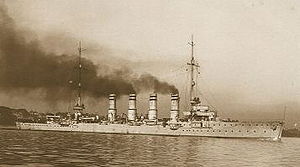- Magdeburg class cruiser
-

SMS StralsundClass overview Builders: AG Weser, AG Vulcan, and Kaiserliche Werft Wilhelmshaven Operators: German Empire Preceded by: Kolberg-class cruiser Succeeded by: Karlsruhe-class light cruiser Planned: 4 Completed: 4 Active: 0 Lost: 3 Retired: 1 General characteristics Class and type: Magdeburg-class light cruiser Displacement: 4,362 tonnes (4,915 full load) Length: 130.5 m Beam: 14 m Draught: 5.48 m Propulsion: Various, see design section Speed: 27 knots (50 km/h) Complement: 354 Armament: 12 × 105 mm (4.1 in) SKL/ 45cal (8 × 1), 2 × 500 mm (19.7 in) TT, 120 mines The Magdeburg class of light cruisers was a group of four ships built for the German Imperial Navy before World War I. The ships were all laid down in 1910, and completed by the end of 1912. One ship of the class, Breslau, is famous for escaping through the Mediterranean at the start of the First World War, before being transferred to Turkish service.
Contents
Design
Dimensions and machinery
The ships of the class were 130 m at the waterline, and 130.5 m overall. The ships had a beam of 14 m, a draught of 5.48 m, and displaced 4,362 tonnes normally, and 4,915 tonnes at a full load.[1] The ships had different power plants; Magdeburg and Stralsund had 3 shaft Bergmann turbines, which delivered 25,000 shp and a top speed of 27 knots (50 km/h). Breslau had 4 shaft AEG-Vulcan turbines, which also produced 25,000 shp (19,000 kW) and a top speed of 27 knots (50 km/h), while Strassburg had 2 shaft Navy turbines, which also delivered the same horsepower and speed.
Armament
The ships of the class were all originally armed with twelve 105mm (4.1 in) guns in single mounts, along with two 500mm (19.7 in) torpedo tubes, and 120 mines. In 1915, Stralsund was rearmed with seven 150mm (5.9 in) guns and two 88mm (3.4 in) anti-aircraft guns, with Strassburg receiving the same rearmament in 1916. Breslau, by that time in Ottoman service as the Midilli, was re-equipped with two 150 mm guns in 1916, and by 1917, had a full armament of eight 150 mm guns.
Service history
The lead ship of the class, Magdeburg, led a short service life. The ship ran aground near the Odensholm lighthouse in the Baltic Sea on 26 August 1914. Efforts to refloat the ship failed; the Russian cruisers Bogatyr and Pallada arrived and destroyed the ship with gunfire.
Breslau was assigned to the Mediterranean Division at the start of World War I. On 4 August, the ship bombarded Bona[disambiguation needed
 ], three days later, the ship indecisively engaged the British light cruiser HMS Gloucester. On 16 August, the ship was sold to the Ottoman Empire, but retained her German crew. The ship operated in the Black Sea, participating in several raids and battles with the Russian fleet. On 20 January 1918, Breslau attempted to raid British naval forces near the Dardanelles; she sank two British monitors, but was sunk after she struck 5 mines.
], three days later, the ship indecisively engaged the British light cruiser HMS Gloucester. On 16 August, the ship was sold to the Ottoman Empire, but retained her German crew. The ship operated in the Black Sea, participating in several raids and battles with the Russian fleet. On 20 January 1918, Breslau attempted to raid British naval forces near the Dardanelles; she sank two British monitors, but was sunk after she struck 5 mines.Straßburg was assigned to the II Scouting Group at the start of World War I. On 28 August 1914, she took part in the Battle of Heligoland Bight, and was moderately damaged. After the end of the war, the ship was ceded to Italy, and sunk by air attack during World War II.
Stralsund was also assigned to the II Scouting Group, alongside her sistership Strassburg. She participated in the Battle of Dogger Bank on 24 January 1915, as part of the support for Admiral Hipper's battlecruisers in the I Scouting Group. After the war, Stralsund was ceded to France as war reparations, and sold for scrap in 1933.
See also
 Media related to Magdeburg class cruiser at Wikimedia Commons
Media related to Magdeburg class cruiser at Wikimedia CommonsReferences
Magdeburg-class cruiser Kaiserliche Marine
Kaiserliche MarineBreslau · Magdeburg · Strassburg · Stralsund
 Ottoman Navy
Ottoman NavyMidilli (ex-Breslau)
 French Navy
French Navy
Mulhouse class Regia Marina
Regia MarinaTaranto (ex-Strassburg)
Preceded by: Kolberg class · Followed by: Karlsruhe class
List of German Imperial Navy ships · List of naval ships of GermanyDreadnought battleships Pre-dreadnought battleships Battlecruisers Armored cruisers Light cruisers Protected cruisers Aircraft carriers - "I"X
U-boats - S — Single ship of class
- X — Cancelled
- V — Conversions
Categories:- Cruiser classes
- Magdeburg class cruisers
- World War I cruisers of Germany
Wikimedia Foundation. 2010.

